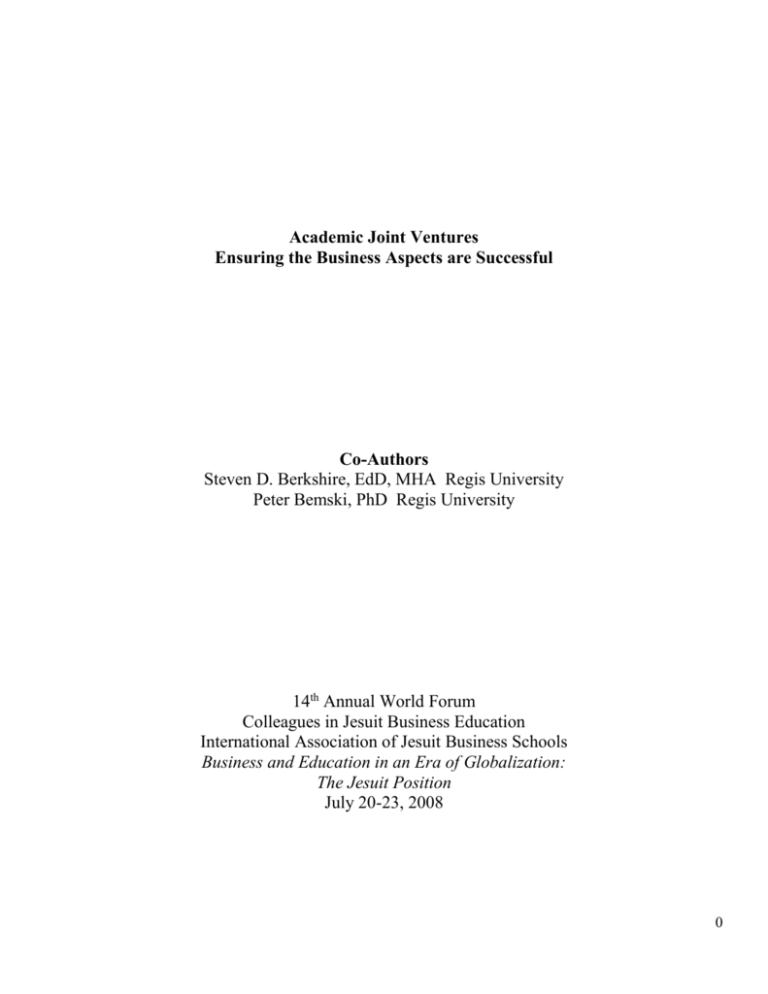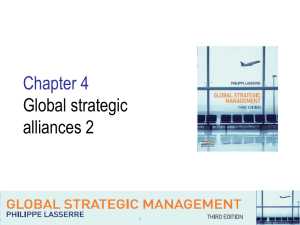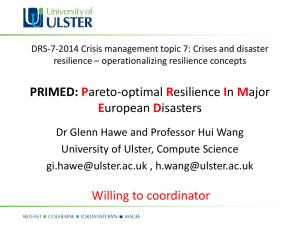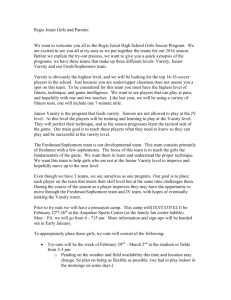Academic Joint Ventures - International Association of Jesuit
advertisement

Academic Joint Ventures Ensuring the Business Aspects are Successful Co-Authors Steven D. Berkshire, EdD, MHA Regis University Peter Bemski, PhD Regis University 14th Annual World Forum Colleagues in Jesuit Business Education International Association of Jesuit Business Schools Business and Education in an Era of Globalization: The Jesuit Position July 20-23, 2008 0 Academic Joint Ventures – Ensuring the Business Aspects are Successful Steven D. Berkshire, EdD, MHA Regis University Peter Bemski, PhD Regis University Introduction As with any business partnership between an U.S. corporation and a Latin American corporation, universities that partner to offer academic programs must consider the financial and operational aspects of such partnerships. This paper deals with international partnerships between universities as laboratories for collaboration between businesses. The elements that make for a successful joint venture go beyond the academic issues of content and how that content is delivered to students. This paper deals with the business and inter-university relationships in developing and implementing joint or collaborative degree programs between universities. It does not deal with traditional exchange programs or dual degree programs where one of the universities is the dominant institution at which the students actually earn the degree.; rather the collaboration here deals with the joint development and offering of curriculum by the institutions as equal partners that leads to the awarding of a joint or collaborative degree. Regis University, founded in 1877, is one of twenty-eight Jesuit universities in the United States. The university enrolls more than 16,000 students who study at its Denver, Colorado campus, seven other regional campuses and online via distance learning. The University has developed relationships with the University of Ulster in Northern Ireland, the National University of Ireland in Galway, Ireland, and ITESO in Guadalajara, Mexico as well as other relationships with schools in other parts of the world. This paper concentrates on the relationships with the Ulster, Galway and ITESO for purposes of the research model. The University of Ulster is the major university in Northern Ireland and is part of the higher educational system in the United Kingdom. Ulster is similar to Regis University in that both have multiple campus that serve diverse populations and both have extensive online educational programs. The National University of Ireland in Galway is involved in extensive educational partnerships throughout Europe and in Asia as well as providing extensive continuing education degree programs for working adults within the country. ITESO, located in Guadalajara, Mexico, is a Jesuit university as is Regis University. ITESO offers a significant number of academic and continuing professional development programs for working adults and via its distance education programming. ITESO participates in an extensive network of schools throughout North and Latin America as well as in Europe and Asia. Literature The educational literature has a great deal of research concerning the traditional student exchange programs between international universities as well as study abroad, and dual degree programs, yet there is little about the development and operation of jointly developed and operated degree programs. The dual degree programs in the literature tend to be collaborations where one of the universities offers the degree (typically the U.S. partner) and the other school provides students. In many cases these dual degree programs allow the students of either 1 school to transfer a specific number of courses into the other degree and to take courses at each school. But the students are usually considered degree seeking at the dominant partner in the relationship. What needs to be looked at is how we develop and ensure that both the U.S. school and the school in the other country is a full and equal partner in the collaboration. One such partnership that seems to signal such a change is the joint partnership between the British Council and the nation of Brazil. In an article describing this partnership Canto and Hannah (2001) stated that “(e)quality in the provision of funds has a practical and symbolic significance …, signifying that this is a collaboration that sets out to replace traditional north-south relationships of donor and recipient with genuine academic partnerships” (p. 27.) What the authors were trying to say and what seems to be needed in developing such international collaborations is that there is a need for mutual respect and participation where both organizations bring similar or complementary skills and resources to the table as opposed to the traditional model which typically has the U.S. or European university providing the actual educational opportunities at the U.S. school with the majority of the students coming from the other country. What their paper attempts to do is examine the relationship between the U.S. school and the Latin American school in a different light. Canto and Hannah (2001) paraphrased Altbach (1981) in which Altbach commented on the dilemma third world universities then had in gaining recognition even though academic performance and research in the third world had improved greatly over the years since World War II. It seems that the perception was that the institutions in the U.S. and Europe have the monopoly on knowledge and the third world is in need of that knowledge. Such attitudes continue and have limited cooperation and collaboration. Canto and Hannah believe that since the late 1970’s schools in the U.S. and Europe have entered into horizontal partnerships that include three elements: “(a) the existence of previous knowledge of the other partner to establish realistic expectations” which came from Samoilovich’s work in the 1990’s, “(b) the genuine sharing of each other’s experiences” which they got from work done by Balan in the 1990’s, and “(c) the application of each other’s knowledge rather than a one-way transfer” of knowledge from the dominant school, which came from work done by Bor and Shute in the 1990’s. (2001, p. 32.) Some issues identified by Canto and Hannah (2001) include: 1. having a clear understanding of each partner’s strengths and weaknesses, 2. having a great deal of trust in each other, 3. low levels of conflict 4. an equal partnership where both partners are respected for what each brings to the relationship, 5. recognizing that language can be a barrier, and 6. having respect for each school’s cultural differences. Canto and Hannah (2001) also looked at three links that need to be considered. These are linguistics, sociology, and technology. Each of these needs to be considered when developing a partnership where both schools play an equal role in developing the academic curriculum and planning the business model for operations. This was re-enforced by Shaw (2006) who speaks to the importance of understanding political environments in each country as well as within each institution involved in the partnership. He further commented that the “(s)tability of a joint venture refers to the longevity of the relationship, and it is dependent, in part, upon the combination and communication between the…partners” (p. 439.) Shaw (2006) also identified barriers that must be considered in developing partnerships in the academic arena. These tend to support what Canto and Hannah (2001) noted in their research. Shaw spoke to financial support, division of work and control, conflict, cultural differences, and environmental factors (p. 442.) An interesting fact is that international joint ventures have declined in number over the past decade (Popper, 2002) and while Popper is speaking generally about multinational companies, she notes that much of the decline is because the partners have different interests. Popper’s comments tend to support the discussion above concerning issues to be watchful about when developing collaborations between U.S. or European universities and their counterparts in Latin America. Chowdhury and Chowdhury (2002) comment that it is important to develop “synergy among the partner firms (p. 52.) They further speak to the symmetric firms having an incentive for forming the partnership in the need to increase demand (p. 57.) If this is translated into an educational partnership, then the goal may well be to 2 increase demand for higher education in one or both countries – or at least the demand for an education from the partner schools. Finally Nadler and Nadler (1990) speak to the need to consider the human resource requirements in joint ventures. They commented that “the variation in cultural norms from country to country should be recognized and understood” (p. 71) when considering human resource issues. Each partner may have different skills and knowledge to lend to the collaboration and this needs to be understood and planned for. Nadler and Nadler further noted that both partners in a joint venture must understand that each partner may lack some human resources capacity and that may need to be developed. Lessons Learned from Regis University and its Partners Relationship Building The literature clearly noted that one of the keys to success with international collaborative ventures is the development of relationships (Canto & Hannah, 2001, Shaw, 2006, Popper, 2002, Chowdhury and Chowdhury, 2002, and Nadler & Nadler, 1990.) Based on an analysis of the international collaborations between Regis University, Denver, Colorado and the three international partners introduced earlier, relationship building probably is foremost in those elements that ensured success and when not fully developed, resulted in failure. Prior to starting to develop any academic programs with ITESO in Guadalajara and the National University of Ireland in Galway (NUIG) both schools spent considerable time getting to know each other. In the case of NUIG the partnership began with senior officials at both schools meeting through a third party and then simply exploring potential opportunities over a couple of years. The same occurred with ITESO. Representatives of both schools first met through a conference sponsored by AJCU and AUSCAL in Guadalajara and then about a year later at an IAJBS educational conference. That led to further contacts and visits. During these meetings and social contacts, both parties got to know the people and their cultures, and developed a trusting relationship. In the first case, these contacts led to the formation of a joint Irish Studies program online between NUIG and Regis University. The program was designed to be small in order to develop a working relationship and has continued. Later that program led to the development and implementation of an online graduate degree in software engineering. The relationship at ITESO resulted in implementation of a joint MBA degree where students from both schools can earn an additional degree from each by taking core courses at the home institution and then a series of courses at the other. This relationship is now allowing ITESO and Regis University to look at moving into a jointly offered degree for the rest of Latin America. An example of a program that probably failed because the relationship was not adequately developed before trying to implement a program was the joint MS degree in International Management between Regis University and the University of Ulster in Northern Ireland. Here the decision to move forward was made very quickly by the top administrators in each school. No time was allowed for the faculty of each university to get to know each other and work together before planning. This resulted in miscommunications about curriculum, policies, culture in each country and the schools themselves, as well as other administrative issues. When the numbers of students did not materialize in the beginning, it was easy to simply terminate the agreement. Relationship building in any business venture is vital to the success of the venture. In higher education it may be even more important since the success of the joint venture or collaboration depends on people entirely. The strength of the Regis-NUIG relationship is a personal one between a couple of individuals at each institution that has led to other personal relationships between faculty and staff at each school. While there is a common language, there are still differences in culture and framework. ITESO is a Jesuit university as is Regis University so there was an existing bond, yet it was the development of the personal relationships between faculty and staff at both schools that ensured a successful partnership. Financial Issues Financial issues can be a deal-breaker if not handled appropriately in any joint venture, but perhaps even more so when working across international borders. The development of a strong trusting relationship will help both partners work through conflicts that may arise concerning who contributes what financial and physical resources and how expenses are accounted for. 3 The relationship with ITESO was assisted by a grant from the First Data/Western Union foundation that provided monies to do some conferences in Mexico for civil sector workers and organizations with ITESO and others taking a leadership role in Mexico. The grant also provided dollars to start planning a certificate (diploma) program in the civil sector area and for bringing some faculty from ITESO to Regis during the summer intensives the University holds each year. From this beginning the business and management faculties began talking about the joint MBA concept which later developed into the current offering between the two schools. There are a number of ways to develop the business plan that can impact the financial resources needed for the successful implementation of the collaborative effort. One model is to simply have each school pay for its own costs and then split the revenues generated. This avoids the problem of determining methods for allocating expenses. Each institution decides what budgetary expenses should be included in the project. It may also avoid the problem of costs at one location being more or less than the other. One disadvantage may be that the model relies on each to equitably support the operational expenses. If the collaboration is online there probably needs to be some formula for the online production and hosting of the courses. Sharing the revenues also has advantages and disadvantages. It does assume that there is some equity in the numbers of students recruited by each partner; otherwise, it is possible one school is contributing more than the other. A second model is to still have each school budget its own expenses, but have each school keep the revenues it generates through its own recruiting efforts. This model might include each school compensating the other when a student takes a course(s) from the other school. Or each school simply keeps the revenue it generates. The advantage to this model is that it is clear and each school is separately at risk. The disadvantage is that assuming costs are equal in most cases, one school may generate more revenue than the other one and therefore the partnership might be uneven. A third model is to develop a single agreed upon budget and then allocate costs based on what services and resources are provided by each institution. It follows that revenues would also be allocated on a similar formula. This model ensures that each school is accountable to the whole since each has a stake in the outcome. Like the previous model the challenge will be to keep some sort of parity in the relationship. Costs for such collaborations include: marketing and recruiting expenses, production costs for online development, faculty and staff costs, collections expenses and other administrative overhead, and start-up expenses. Depending on the size of the collaboration these can be quite costly to each organization. Each of these will be dealt with in various sections of the paper to follow. Another element of finances to think about is the international monetary exchange rate and how that is calculated. Historically, the exchange has been based on the U.S. dollar, but in the current economic environment the variation in exchange rates takes on an importance that may not have been there in the past. If the two schools share revenues, it can be problematic determining at what point the exchange rate is fixed. Along with the exchange rate is the question of whose currency payments are made in. Each partner may be charging tuition in its own currency which makes it difficult to determine if the charges to students are equivalent. Such negotiations have had significant impacts on the collaborations between Regis University and its partners. The collaboration with NUIG requires each partner to budget its own expenses, however, there is a formula for items such as marketing expenses and some overhead that vary between countries. In Europe it is common to not charge students for required texts and to use other sources, while in the U.S. students typically pay for their own books and more often than not textbooks are required. How do the partners determine an equitable way of dealing with these differences? Both Regis and NUIG agreed on a formula for splitting the revenues earned from student tuitions; of course, during the first few years there have always been minor negotiations as to how that works at the end of the year when the transfer of monies occurs. With the collaboration with ITESO, the current project has each school responsible for its own expenses including marketing and recruitment. Each school also charges its own tuition for all courses in the program and then each partner compensates the other for those courses taken at the partner school by its students. However, ITESO and Regis University came to an agreement on what the tuition would be for this program. Compensation for students taking courses at the other 4 partner is in that school’s currency. For the Ulster venture, the allocation was more complicated and included negotiating all expenses and costs as well as the tuition rate. Each school shared in the budget based on a negotiated formula. This proved to be somewhat divisive. If either institution is entering the agreement with the intention of serving thousands of students and making significant profits they will likely be disappointed. While learning from one another and entering markets that might have been out of reach are certainly worthwhile and attainable goals, making more than a modest profit is not. The financials developed prior to entering the agreement between Regis University and Ulster promised enormous profit. The failure of this profit to materialize was one more nail in the coffin of that venture. One lesson learned was that keeping it as simple as possible is in the best interest of both partners. While the ITESO collaboration only recently the intention has been that this model will result in a better management process for expenses. Product Development Here we speak in terms of curriculum development as well as production of online courses. It is likely that residents in each country or region of the world will have different needs and desires when it comes to the curriculum, how that curriculum is offered, and what is expected in the way of work. The faculties at both schools need to come to agreement on what the curriculum will include in order to best serve diverse student bodies. The faculties of ITESO and Regis University spent considerable time working together on identifying the learning outcomes for a collaborative MBA and what courses might be appropriate and the amount of time it might take to complete the degrees. In the case of this partnership it was decided that each school would continue to offer courses that already exist. In addition it was determined that each university’s students needed to complete the core at the home school and then take five courses from the other school which would transcripted at both. ITESO teaches its courses in Spanish and Regis teaches its courses in English. For the NUIG collaboration, each school became responsible for developing half of the curriculum, so negotiations centered on what type of courses and content ought to be included and which school is responsible for which courses. This process took considerable time and communications between the faculties at each school. For most of the courses each school was able to adapt its own course work for the collaboration. Regis University and the University of Ulster also developed a model where each school developed half of the curriculum; however, it was decided to start from scratch. The concept included both faculties working together on the content. This created significant problems in coming to agreement and likely also contributed to the eventual termination of the agreement. Production includes determining who and how courses will be written and produced for online presentation. It is imperative that the courses be offered on one platform so the agreement needs to define which school hosts the program and how the faculties of the two schools participate with the development team. Marketing Determining the target market is a significant aspect of the collaboration. The other question that must be asked and answered is who is responsible for doing the marketing and recruitment. In the case of the Ulster collaboration, the negotiated agreement stated that while both schools would do marketing, Regis University would be responsible for most of the effort. Ulster would host the courses on its WebCT platform. This proved to be a problem since the Regis marketing team had no experience selling a program in another country and had to play catch up. With both ITESO and NUIG each school markets to its own market, which seems to be a better approach. This also means that each school identifies who the target market will be. In the case of the Ulster collaboration it was Regis University’s role to identify the European market which proved to be much more difficult than thought. Consideration must be given to doing marketing studies in the countries to be involved. Such studies need to include who are the potential students, their companies, whether the companies assist in paying the tuition, and what the tuition range will be. If the collaboration will include offering the degree program beyond the two countries, what are the global considerations. Agreement is needed between the partners on what is to be marketed. Here again cultural differences and regional differences play a part. What may work in the U.S. is not necessarily what will work in Latin America. 5 One question to ask is whether the potential student population is ready and willing to participate in the program. One assumption is that a combined U.S./Latin American or U.S./European degree is something that will be sought after if offered. And if so are students willing to do so via the internet. It appears that allowing each partner to do its own marketing is the best alternative for a number of reasons. These include knowledge of the local culture and peoples, knowledge of the types of marketing that work best, and costs included. For example in the North American market doing internet sales may be a better approach while in Europe direct sales may work better. Technology Technology is not just the platform and course management system to be used in offering the collaboration. It also includes knowing what technology the potential market has access to, the band width in the countries and sub-regions of countries, costs of access to the internet, and even time zone issues that affect utilization. Latin America has long used satellite transmission and radio transmission for certificate/diploma programs since these technologies have been available. Switching to the internet to transmit educational programs is a new way of doing this, and the potential students need to have access to the technology. And they need to want to do so. One of the lessons obtained from the Ulster collaboration was that the marketing study showed that students in northern Europe had ready access to the internet and to the technology to access it. At the same time the further south in Europe one went the less likely it was that potential students would access the internet either because of no interest or because there was not ready access. A question for the partnership with ITESO is that once it expands beyond the regional area served by ITESO, will potential students have the technology and access to participate. In some cases this may require a commitment from the person’s employer to provide access through the corporate network. Legal and Governmental One often does not think about or consider the legal and governmental issues that can be involved in international collaborations. This is a significant aspect of business partnerships since international trade is governed by many rules and regulations. In most academic exchange programs there are few restrictions even for dual degrees when only one partner actually offers the degree. However, for the types of partnerships addressed by this paper, there are many considerations. First are accreditation issues. For Regis University, the Higher Learning Commission (HLC) of the North Central Association of Schools and Colleges (NCA) must at least review such collaborations prior to their implementation. For the partners there may be a need to have the education ministry for the country review the project and approve it. Such approvals are required if the degrees are to be jointly awarded and the curriculum is being shared by both schools. Issues include transcripting of credits and the degrees, faculty qualifications, academic quality and assessment, and many other concerns. There may be specific governmental restrictions or rules that must be met in each country. These may be academic components or things like student financing issues, travel restrictions, visa requirements if students travel between countries, monetary policies, and contract rules and regulations. An interesting obstacle discovered after the partnership was ready to start in Ireland was the discovery that Irish Constitution requires any degree offered by NUIG to be solely awarded by the National University of Ireland. That created problems since NUIG and Regis had planned on awarding a joint degree for the graduate degree in software engineering. The solution was to have the students decide which country he/she wanted the degree from after which the student completed the capstone for that university. Besides the degree being awarded from either NUIG or Regis University, the schools jointly give the students a parchment that describes the joint venture and that the degree is recorded at each school. The University of Ulster did not have such problems since it is located in Northern Ireland which is part of the United Kingdom. Ulster was authorized to determine its own degree awarding rules and so it was ok to award a joint degree. However, Ulster believed there were other rules that affected how the program could be structured. In both cases outside evaluators needed to be involved at the end of each year to review student progress and pass on whether the students met academic standards. This was something new for Regis University. The rigid rules in Northern Ireland probably also contributed to the conflict that eventually resulted in the program being terminated. 6 ITESO must meet the academic rules in effect in Mexico; however, because of ITESO’s status with the education ministry, it is authorized to develop a collaboration that includes jointly awarding degrees. In addition the Mexican higher education system operates in a manner more similar to the United States model. Another regulatory issue involves criteria used by the Association for the Advancement of Collegiate Schools of Business (AACSB) which often requires that both partners be AACSB accredited. This only affects business and management programs, but since that is the area where most of these ventures will occur the rule is significant. If students must travel to the other location, immigration rules apply. This could be an obstacle for some. Faculty credentials and qualifications are also something to consider. The accreditation bodies will interested how each partner evaluates and assesses the credentials of the faculty involved. Regis University and its partners have chosen to adopt criteria that state that each school accepts the credentialing process of the other school. Language Language is an important factor. Even when the collaboration is between an U.S. school and a European one (including Ireland and the UK) there are communication problems since dialects may be substantially different and hard to understand. The issue of language is even more important when the partnership is between an U.S. university and one in Latin America. One question to answer is whether all or some or none of the faculty need to be bilingual to participate in the program? This seems to have been resolved with the Regis/ITESO collaboration. Since the courses taught by ITESO are in Spanish and the ones taught by Regis are taught in English, it was decided that being bi-lingual is not necessary. It is necessary of the students, however. Clarity is also something to consider in joint ventures. Given cultural and language differences it is very important to frequently confirm that all parties are talking about the same things. Even when there is a common language, such as American English and British or Irish English, false cognates (i.e. disciplinas and Disciplines; cursos and courses… etc.) further complicate the matter. Frequent rephrasing and review help to overcome such problems. As Canto and Hannah (2001) noted, language can be an obstacle and must be considered. Language also impacts how each partner approaches marketing. Leadership Issues Effective leadership is a must in any collaboration. The senior leadership/management at both partners must be actively supportive of the venture. This includes a commitment for both administrative and financial support as well as providing ample resources for faculty. Without such commitment it will be much more difficult to implement and maintain the collaboration. However, such commitment can also be a negative if each partner does not involve the middle management leaders and faculty early on. One example of where leadership ended up being a major problem was the collaboration between Regis University and the University of Ulster. The agreement to go forward was made by the Vice Chancellor of Ulster and the request to participate came from him without much work done to develop the relationship with the Faculty of Business and Management at Ulster. There was resistance to this new venture, especially since the faculty believed they were already successful and were not sure they wanted to do this project. Both schools also appointed faculty leads who did not communicate well with each other which all too often met conflict and disagreements. On the other hand, the senior leadership at both ITESO and NUIG were supportive from the beginning, but they knew that it was important to build the relationship first. In both cases the presidents or other senior leaders encouraged collaboration and allowed for the relationship to develop. Faculty were also empowered. This reduced the likelihood there would be resistance and conflict. Any time there are changes in leadership and/or structural changes to an institution it may make it more difficult for a fledgling agreement to move forward. Any relationship such as those described in this paper is bound to initially be dependent in part on the personal relationships established between the representatives of the institutions rather than between the institutions themselves. Only with time will be relationships become 7 institutional rather than personal and even then it is incumbent on both institutions to proactively work to ensure the ongoing vitality of the relationship. Leader support is vital to such endeavors since resources need to be committed and there is a likely need to expend fund long before any program is actually launched. Academic Outcomes Obviously academic quality is central to any collaboration. Students in such ventures want to be assured that the degree will be respected and will open doors. One reason students will want to matriculate in such joint collaborations is to get a position in an international organization, whether that is in computer science or business. This takes ongoing and continuous work and collaboration between the faculties, assessment of learning outcomes, and ensuring quality experiences for students. Part of this includes working with the partner. For example, in the collaboration with NUIG, both schools committed to using the outside reviewer model to annually evaluate and assess student accomplishments. Training and continuing education for faculty is vital in such partnerships. Faculty from different countries must work collaboratively. To do this these must be commitment to academic quality as well as quality and readily available student service and advising. Final Notes There are excellent reasons to look at forming international collaborations to offer joint degree programs. Such collaboration ensures international bridges between countries and cultures. In a changing world environment it may be even more important that students and faculty, especially at the graduate level, experience international cultures and education. Much of what must be practiced externally in order to make such collaborations work is no unlike that which should be in place internally. Transparency, respect for one another, fiscal responsibility, realistic expectations, quality control and a shared desire to serve students and learn from one another certainly will make such collaborations more likely to succeed. It is also important to recognize that they may not all succeed and that learning from those that don’t is only more likely to make subsequent efforts, with the same or different partners, more rewarding. Jesuit education efforts have reached out to the world since shortly after Ignatius of Loyola brought together his small band of companions. Ignatian humanism and spirituality tell us that it is important to start with a person’s experiences and then to build on them, to bring understanding among all peoples. International collaborations to offer joint degree programs bring these Jesuit values together across borders and across oceans. References Canto, I & Hannah, J (2001) A partnership of equals? Academic collaboration between the United Kingdom and Brazil. Journal of Studies in International Education. 5. pp 26-41. Chowdhury, I.R. & Chowdhury, P.R. (2002) International joint ventures: A welfare analysis. Policy Reform 5(1) pp. 51-60. Nadler, L. & Nadler, Z. (June 1990) International joint ventures and HRD. Training & Development Journal. pp. 71-76. Popper, M. (May 20, 2002) Flying solo overseas. Business Week 3783 p. 28 Shaw, S. (Summer 2006.) Launching international collaboration for international research. Sign Language Studies, 6(4) pp. 438-453. 8





